Joe and Mary
Ann McDonald's
Wildlife Photography
June 2004
Question of the Month
The Canon 1D Mark II
- is it the ultimate camera for wildlife photography?
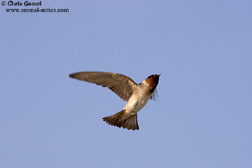 Everyone,
it seemed, eagerly awaited Canon's latest digital camera, the
Mark II, and rumors abounded about what the camera would feature.
Everyone, it seems, had one on order as well, sight unseen. Oddly
enough, I did not, but a prescient friend put me on the wait list/order
list at Allen's Camera because he knew me and knew I'd want the
camera -- so I got one of the first ones out there.
Everyone,
it seemed, eagerly awaited Canon's latest digital camera, the
Mark II, and rumors abounded about what the camera would feature.
Everyone, it seems, had one on order as well, sight unseen. Oddly
enough, I did not, but a prescient friend put me on the wait list/order
list at Allen's Camera because he knew me and knew I'd want the
camera -- so I got one of the first ones out there.
But I didn't have time to shoot it right, to really put it
through the wringer to test out exactly how great the camera was.
My friend, Chris Gamel (www.animal-antics.net),
took his Mark II to the Bear River NWR in Utah to really push
the envelope, attempting to shoot cliff swallows in flight. As
Chris reported, he had just about dispaired to ever get a swallow
in flight (short of using a Phototrapper (see
www.phototrap.com),
and High Speed Flashes (see Fotronix's).
Chris sent me this image of a flying
cliff swallow, and later, several more, that really whetted my
appetite. The Mark II caught the bird in focus, and Chris, to
his credit, caught the bird in his viewfinder, for if you have
ever tried tracking swallows you know how eratic their flight
can be and how difficult it is to keep one within your viewfinder.
Graeme Guy in Singapore (see Singapore
Nature Photo Society's website) reported similar success from
Asia, so I was drooling by this time. Last week I had a chance
to finally put my Mark II through a demanding test of flight shooting,
shooting with my good buddy Sam Maglione in coastal New Jersey.
We worked on terns, gulls, ospreys, and shorebirds.
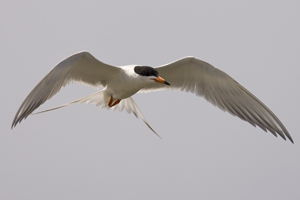 Any
good AF system should do a pretty good job with gulls, as they
fly fairly slow and steady. Terns are a bit more demanding, but
the M2 seemed to keep up on most images. In fact, about 80% of
my shots of the gulls and terns when viewed full-sized on my monitor
looked critically sharp. Many were not when viewed at 100% as
I edited with a Capture 1
program (a beta version, as the original Capture 1 did not support
the M2 but the latest version will.). As an aside, although I
had problems with the beta version where it crashed I found that
I would rather put up with that than go through Photoshop to open
a RAW file, click on it to enlarge an area to discern sharpness,
cancel, and go on to the next image. Too tedius.
Any
good AF system should do a pretty good job with gulls, as they
fly fairly slow and steady. Terns are a bit more demanding, but
the M2 seemed to keep up on most images. In fact, about 80% of
my shots of the gulls and terns when viewed full-sized on my monitor
looked critically sharp. Many were not when viewed at 100% as
I edited with a Capture 1
program (a beta version, as the original Capture 1 did not support
the M2 but the latest version will.). As an aside, although I
had problems with the beta version where it crashed I found that
I would rather put up with that than go through Photoshop to open
a RAW file, click on it to enlarge an area to discern sharpness,
cancel, and go on to the next image. Too tedius.
Sam showed me an osprey nest only 15 feet high, right next
to a road. Unfortunately the birds were shy so we had to move
a considerable distance back to keep from disturbing the birds.
When an adult would fly in, it would typically circle, giving
us plenty of chances for snaps. Again, ospreys are not fast flying,
erratic birds, so the camera wasn't especially challenged. It
showed -- everything was a keeper.
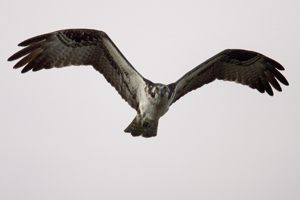 Noise
levels are supposed to be much reduced in the M2 and my very unscientific
test seemed to confirm this. The light level was quite low and
I was shooting at ISO 400, and even then the images were on the
dark side. I did most of my corrections with Capture 1 during
the RAW conversion, and PS CS did the rest. There was still some
'grain' or noise visible, but not bad -- certainly it did look
better than what my 1Ds achieved.
Noise
levels are supposed to be much reduced in the M2 and my very unscientific
test seemed to confirm this. The light level was quite low and
I was shooting at ISO 400, and even then the images were on the
dark side. I did most of my corrections with Capture 1 during
the RAW conversion, and PS CS did the rest. There was still some
'grain' or noise visible, but not bad -- certainly it did look
better than what my 1Ds achieved.
All of the images were made with a 600mm f4 lens with a 1.4X
tele-converter attached. Since the M2 has a built-in 1.3 magnification
factor, I was finding and tracking birds with the equivalent of
a 1092mm lens! That is a lot of glass and magnification, offering
an extremely limited angle of view. Finding a subject can be challenging,
and indeed it was when I really put the M2 to the test -- shooting
shorebirds in flight.
For this we went to Reed's Beach, a world-famous birding site
where red knots and ruddy turnstones gather to eat horseshoe crab
eggs by the millions to fatten up for their final migratory push
to their arctic nesting grounds. Had I written this sentence ten
years ago I'd have added 'red knots
and ruddy turnstones gather by the thousands (hundreds of thousands?)
to eat' but that is no longer the case. Over-fishing
of horseshoe crabs, for FERTILIZER for chicken farms, I believe,
has decimated the horseshoe crab population. A decade ago Mary
and I used to do a weekend photo tour to this area for shorebird
photography, and the beaches were lined end to end with crabs.
Now, we saw scattered clumps, and this was on the day supposedly
peak for crab breeding and for shorebird activity. Instead of
seeing thousands of red knots I saw, at most, a few hundred, and
I honestly believe I saw less than 100 knots. Living Bird Quarterly
did an article on this, warning that the red knot could go extinct.
My first-hand look would sure add credence to that fear.
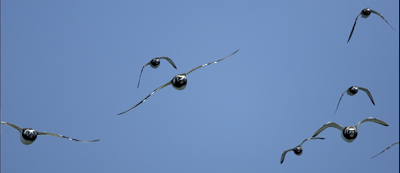 This
image is a composite of two, comprised of bigger turnstones for
one shot, and the smaller background birds for the other. That's
why everything looks in focus. Both shots are cropped, but both
were acceptably sharp for publication purposes. Shorebirds fly
at least 30mph and maybe closer to 50 -- at any rate, they really
whip, and it was a real challenge at 1100mm getting them in the
frame. I was amazed that the camera kept up as well as it did
with a bird flying straight at the camera.
This
image is a composite of two, comprised of bigger turnstones for
one shot, and the smaller background birds for the other. That's
why everything looks in focus. Both shots are cropped, but both
were acceptably sharp for publication purposes. Shorebirds fly
at least 30mph and maybe closer to 50 -- at any rate, they really
whip, and it was a real challenge at 1100mm getting them in the
frame. I was amazed that the camera kept up as well as it did
with a bird flying straight at the camera.
Side-ways shots were less of an issue if I could keep the birds
in the frame, which certainly was an issue.
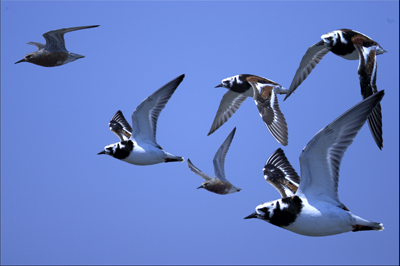
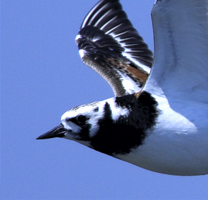 The
image of the multiple birds is again a composite, but it pretty
accurately reflects what a flock of birds look like as they zip
by. The closeup should give you an idea of sharpness. For example,
the TIFF conversion resulted in an image that was almost 44 inches
long based on the image size I had set in PS, and the turnstones
filled no more than 12 inches of that. So, 1/4th or 1/5th of the
frame. I'd crop this so that a bird essentially filled my new
frame at 8x12, and at View at Print Size the image was incredibly
sharp.
The
image of the multiple birds is again a composite, but it pretty
accurately reflects what a flock of birds look like as they zip
by. The closeup should give you an idea of sharpness. For example,
the TIFF conversion resulted in an image that was almost 44 inches
long based on the image size I had set in PS, and the turnstones
filled no more than 12 inches of that. So, 1/4th or 1/5th of the
frame. I'd crop this so that a bird essentially filled my new
frame at 8x12, and at View at Print Size the image was incredibly
sharp.
Remember, we're talking about a bird flying by at close to
50mph, shot with a 1100mm lens. I used a Wimberley action head,
and I felt like a desperate gunner on a WWII boat firing at dive-bombing
planes. As I said to Sam, I would hope a gunner would have better
luck keeping a plane in his sights than I did with these shorebirds!
I never thought I'd have a chance to get sharp images of flying
shorebirds. Years ago, it was virtually impossible. I did shoot
a lot of images, maybe 400 in total, and I only kept about 40
for further consideration. With film, that would have represented
10 rolls, at a total cost of approximately $100 or so. With digital,
it was free -- or no more than the cost of the Memory card that
I could use over and over again.
This test may have marked my swan song with film. I don't see
the point, unless all of us pros find that the markets simply
won't accept digital images. That is not going to happen. In short,
I loved the camera and it will become my wildlife camera of the
future.
One GLITCH - at the end of the day I tried shooting a final
subject and my AF custom function, 4-1, wasn't working. I thought
that odd, and tried to change my CF via the screen, but it wouldn't
light up. Virtually all the electronics were frozen up with the
exception of the operating mode (Manual - Tv - Av - P) which unlocked
the freeze up once I tried it. Prior to that I tried taking out
the battery to clear the computer, turning the camera on and off,
anything I could think of, but nothing worked. Hopefully this
isn't a problem I'll see again, or is that a problem stirring
in the depths of our M2s!
As I write this, June 2004, the Mark 2 is in very limited supply.
As I mentioned earlier, I bought mine from Allen's Camera,
215 547-2841, and I buy virtually all of my camera equipment
from Allen. His prices meet and usually beat B&H's or any
other catalog mailorder house; his service is personal; and his
attention to your needs and his honesty is without parallel. Check
him out!
Oops, almost forgot, I don't know if I really answered the
Question of the Month. If the writeup didn't clue you in to the
answer, then I'll be direct:
YES!
Previous Questions
of the Month
KEY:
|
Exposure |
DIGITAL |
Camera Techniques |
Flash-Remotes |
In the Field |
NANPA |
Contact us by e-mail:info@hoothollow.com
Or FAX us at: (717) 543-6423.
Return to Home
Page.
 Everyone,
it seemed, eagerly awaited Canon's latest digital camera, the
Mark II, and rumors abounded about what the camera would feature.
Everyone, it seems, had one on order as well, sight unseen. Oddly
enough, I did not, but a prescient friend put me on the wait list/order
list at Allen's Camera because he knew me and knew I'd want the
camera -- so I got one of the first ones out there.
Everyone,
it seemed, eagerly awaited Canon's latest digital camera, the
Mark II, and rumors abounded about what the camera would feature.
Everyone, it seems, had one on order as well, sight unseen. Oddly
enough, I did not, but a prescient friend put me on the wait list/order
list at Allen's Camera because he knew me and knew I'd want the
camera -- so I got one of the first ones out there. Any
good AF system should do a pretty good job with gulls, as they
fly fairly slow and steady. Terns are a bit more demanding, but
the M2 seemed to keep up on most images. In fact, about 80% of
my shots of the gulls and terns when viewed full-sized on my monitor
looked critically sharp. Many were not when viewed at 100% as
I edited with a
Any
good AF system should do a pretty good job with gulls, as they
fly fairly slow and steady. Terns are a bit more demanding, but
the M2 seemed to keep up on most images. In fact, about 80% of
my shots of the gulls and terns when viewed full-sized on my monitor
looked critically sharp. Many were not when viewed at 100% as
I edited with a  Noise
levels are supposed to be much reduced in the M2 and my very unscientific
test seemed to confirm this. The light level was quite low and
I was shooting at ISO 400, and even then the images were on the
dark side. I did most of my corrections with Capture 1 during
the RAW conversion, and PS CS did the rest. There was still some
'grain' or noise visible, but not bad -- certainly it did look
better than what my 1Ds achieved.
Noise
levels are supposed to be much reduced in the M2 and my very unscientific
test seemed to confirm this. The light level was quite low and
I was shooting at ISO 400, and even then the images were on the
dark side. I did most of my corrections with Capture 1 during
the RAW conversion, and PS CS did the rest. There was still some
'grain' or noise visible, but not bad -- certainly it did look
better than what my 1Ds achieved. This
image is a composite of two, comprised of bigger turnstones for
one shot, and the smaller background birds for the other. That's
why everything looks in focus. Both shots are cropped, but both
were acceptably sharp for publication purposes. Shorebirds fly
at least 30mph and maybe closer to 50 -- at any rate, they really
whip, and it was a real challenge at 1100mm getting them in the
frame. I was amazed that the camera kept up as well as it did
with a bird flying straight at the camera.
This
image is a composite of two, comprised of bigger turnstones for
one shot, and the smaller background birds for the other. That's
why everything looks in focus. Both shots are cropped, but both
were acceptably sharp for publication purposes. Shorebirds fly
at least 30mph and maybe closer to 50 -- at any rate, they really
whip, and it was a real challenge at 1100mm getting them in the
frame. I was amazed that the camera kept up as well as it did
with a bird flying straight at the camera.
 The
image of the multiple birds is again a composite, but it pretty
accurately reflects what a flock of birds look like as they zip
by. The closeup should give you an idea of sharpness. For example,
the TIFF conversion resulted in an image that was almost 44 inches
long based on the image size I had set in PS, and the turnstones
filled no more than 12 inches of that. So, 1/4th or 1/5th of the
frame. I'd crop this so that a bird essentially filled my new
frame at 8x12, and at View at Print Size the image was incredibly
sharp.
The
image of the multiple birds is again a composite, but it pretty
accurately reflects what a flock of birds look like as they zip
by. The closeup should give you an idea of sharpness. For example,
the TIFF conversion resulted in an image that was almost 44 inches
long based on the image size I had set in PS, and the turnstones
filled no more than 12 inches of that. So, 1/4th or 1/5th of the
frame. I'd crop this so that a bird essentially filled my new
frame at 8x12, and at View at Print Size the image was incredibly
sharp.